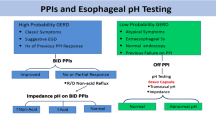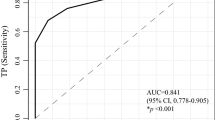Abstract
Objective
Diagnosis of laryngopharyngeal reflux (LPR) is still challenging. Recently a diagnostic device for pH values in the aerosolized environment of the pharynx has been introduced (Dx-pH). We evaluated results of Dx-pH with objective criteria of pH/impedance monitoring (MII) and subjective reflux scoring systems and assessed day-to-day variability.
Design
This study makes use of a prospective single-center trial. Thirty patients with suspected LPR were analyzed. Upper endoscopic examination, manometry, phoniatric examination, and reflux scores were assessed. Dx-pH was performed on two consecutive days, first in combination with MII and second as single measurement. Thereafter, proton pump inhibitor (PPI) trial was performed. Patients were interviewed about symptom relief after 3 months.
Results
There were considerable differences between MII and results on Dx-pH: day 1 (agreement 11 out of 30, kappa 0.137) and day 2 (agreement 14 out of 30, kappa 0.036). Statistically significant differences were detected correlating all single reflux episodes (n = 453) of Dx-pH with MII and vice versa. Furthermore acidic reflux episodes did not result in pH drops of the pharynx. There was a fair agreement between Dx-pH measurements on subsequent days. After follow-up, 3 out of 18 patients with pathological Dx-pH results reported positive response to PPIs, in contrast to 5 out of 6 patients with pathological MII.
Conclusion
According to our data, acid pharyngeal pH levels detected with Dx-pH are not related to GERD and acid esophageal reflux episodes do not result in pharyngeal pH alterations. Hence, present etiology of LPR needs to be reconsidered since neither mixed nor gas reflux events result in pharyngeal pH alteration. Other acid-producing or retaining factors should be taken into account.




Similar content being viewed by others
References
Ford CN. Evaluation and management of laryngopharyngeal reflux. JAMA 2005 Sep 28;294(12):1534–40.
Rohof WO, Hirsch DP, Boeckxstaens GE. Pathophysiology and management of gastroesophageal reflux disease. Minerva Gastroenterol Dietol. 2009 Sep;55(3):289–300.
Tae K, Jin BJ, Ji YB et al. The role of laryngopharyngeal reflux as a risk factor in laryngeal cancer: a preliminary report. Clin Exp Otorhinolaryngol. 2011 Jun;4(2):101–4. Epub 2011 May 31
Merati AL, Lim HJ, Ulualp SO et al. Meta-analysis of upper probe measurements in normal subjects and patients with laryngopharyngeal reflux. Ann Otol Rhinol Laryngol 2005; 114:177.
Hicks DM, Ours TM, Abelson TI. The prevalence of hypopharynx findings associated with gastroesophageal reflux in normal volunteers. J Voice 2002; 16:564.
Wassenaar E, Johnston N, Merati A et al. Pepsin detection in patients with laryngopharyngeal reflux before and after fundoplication B. Surg Endosc. 2011 Jun 22.
Altman KW, Haines GK 3rd, Hammer ND et al. The H+/K+−ATPase (proton) pump is expressed in human laryngeal submucosal glands. Laryngoscope 2003; 113:1927.
Kullen MJ, Klaenhammer TR. Identification of the pH-inducible, proton-translocating F1F0-ATPase (atpBEFHAGDC) operon of Lactobacillus acidophilus by differential display: gene structure, cloning and characterization. Mol Microbiol. 1999 Sep;33(6):1152–61.
Bredenoord AJ. Impedance-pH monitoring: new standard for measuring gastro-oesophageal reflux. Neurogastroenterol Motil. 2008 May;20(5):434–9.
Bajbouj M, Becker V, Neuber M et al. Combined pH-metry/impedance monitoring increases the diagnostic yield in patients with atypical gastroesophageal reflux symptoms. Digestion. 2007;76(3–4):223–8. Epub 2007 Dec 21
Riphaus A, Wehrmann T, Weber B et al. Sektion Enoskopie im Auftrag der Deutschen Gesellschaft für Verdauungs- und Stoffwechselerkrankungen e.V. (DGVS); Bundesverband Niedergelassener Gastroenterologen Deuschlands e. V. (Bng); Chirurgische Arbeitsgemeinschaft für Endoskopie und Sonographie der Deutschen Gesellschaft für Allgemein- und Viszeralchirurgie (DGAV); Deutsche Morbus Crohn/Colitis ulcerosa Vereinigung e. V. (DCCV); Deutsche Gesellschaft für Endoskopie-Assistenzpersonal (DEGEA); Deutsche Gesellschaft für Anästhesie und Intensivmedizin (DGAI); Gesellschaft für Recht und Politik im Gesundheitswesen (GPRG). S3-guidelines--sedation in gastrointestinal endoscopy. Z Gastroenterol. 2008 Nov;46(11):1298–330. Epub 2008 Nov 14. German
Belafsky PC, Postma GN, Koufman JA. The validity and reliability of the reflux finding score (RFS). Laryngoscope. 2001 Aug;111(8):1313–7.
Belafsky PC, Postma GN, Koufman JA. Validity and reliability of the reflux symptom index (RSI). J Voice. 2002 Jun;16(2):274–7.
Sifrim D, Holloway R, Silny J et al. Acid, nonacid, and gas reflux in patients with gastroesophageal reflux disease during ambulatory 24-hour pH-impedance recordings. Gastroenterology. 2001 Jun;120(7):1588–98.
Becker V, Bajbouj M, Waller K et al. Clinical trial: persistent gastro-oesophageal reflux symptoms despite standard therapy with proton pump inhibitors—a follow-up study of intraluminal-impedance guided therapy. Aliment Pharmacol Ther. 2007 Nov 15;26(10):1355–60. Epub 2007 Sep 26
Shay S, Tutuian R, Sifrim D et al. Twenty-four hour ambulatory simultaneous impedance and pH monitoring: a multicenter report of normal values from 60 healthy volunteers. Am J Gastroenterol. 2004 Jun;99(6):1037–43.
Ayazi S, Hagen JA, Zehetner J et al. Proximal esophageal pH monitoring: improved definition of normal values and determination of a composite pH score. J Am Coll Surg. 2010 Mar;210(3):345–50.
Ayazi S, Lipham JC, Hagen JA et al. A new technique for measurement of pharyngeal pH: normal values and discriminating pH. J Gastrointest Surg. 2009 Aug;13(8):1422–9. Epub 2009 May 7
Haukioja A, Söderling E, Tenovuo J. Acid production from sugars and sugar alcohols by probiotic lactobacilli and bifidobacteria in vitro. Caries Res. 2008;42(6):449–53. Epub 2008 Oct 16
Ayazi S, Hagen JA, Zehetner J et al. Day-to-day discrepancy in Bravo pH monitoring is related to the degree of deterioration of the lower esophageal sphincter and severity of reflux disease. Surg Endosc. 2011 Jul;25(7):2219–23. Epub 2011 Feb 27
Reichel O, Keller J, Rasp G et al. Efficacy of once-daily esomeprazole treatment in patients with laryngopharyngeal reflux evaluated by 24-hour pH monitoring. Otolaryngol Head Neck Surg 2007; 136:205.
Vakil N, van Zanten SV, Kahrilas P, Dent J, Jones R; Global Consensus Group. The Montreal definition and classification of gastroesophageal reflux disease: a global evidence-based consensus. Am J Gastroenterol. 2006 Aug;101(8):1900–20
Conflict of Interest Statement for All Authors
Monther Bajbouj received donations from “Neuwirth Medical Products” (German distributor of the Dx probe).
Author information
Authors and Affiliations
Corresponding author
Additional information
What is already known about this subject?
LPR is assumed to be connected to GERD.
Response to PPI therapy is variable.
Despite sparse data, pharyngeal pH monitoring is used in LPR diagnostics.
What are the new findings?
Acid reflux episodes do not result in pharyngeal pH drops.
Acid pharyngeal pH levels are not related to GERD.
Pharyngeal pH measurement is not a positive predictor for PPI response.
Rights and permissions
About this article
Cite this article
Becker, V., Graf, S., Schlag, C. et al. First Agreement Analysis and Day-to-Day Comparison of Pharyngeal pH Monitoring with pH/Impedance Monitoring in Patients with Suspected Laryngopharyngeal Reflux. J Gastrointest Surg 16, 1096–1101 (2012). https://doi.org/10.1007/s11605-012-1866-x
Received:
Accepted:
Published:
Issue Date:
DOI: https://doi.org/10.1007/s11605-012-1866-x




